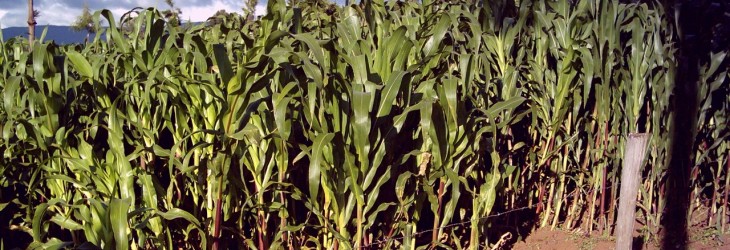Growing maize for food and fodder

It is possible to obtain both fodder for dairy animals and grain for household use or sale from a single crop of maize. This involves planting maize more densely than is usual when growing maize just for grain. Fodder from maize is a good alternative when other fodder crops regenerates too slowly, as can happen after severe drought or frost. It is possible to produce as much as 40 tonnes of green forage per year per hectare by planting maize densely.
Advantages
- More and better quality fodder from the same land
- Fodder from maize when other feed is scarce; saves buying feed off-farm
- Napier is allowed to regrow while fodder fed from maize or the Napier can be harvested and conserved for use in time of scarcity
- Surplus fodder can be sold for cash
Disadvantages
- The major disadvantage to dense planting is the increased requirement for fertilizer and manure
- When using a higher seed rate, beans should not be planted in the same hole as maize but in between the maize rows. This may result in increased labour requirement.
- Bean yields are reduced where maize is intercropped with beans
- Dense planting produces many smaller cobs. Tis may present an obstacle to selling green maize for roasting. If the maize is harvested dry, it will require more labour for harvesting and shelling
Methods
Fodder can be obtained from a maize crop by:
- Thinning: This is removal of weak, thin and sick plants whilst weeding the crop or as need for fodder arises. Maize thinnings are of high nutritive value and can be obtained even after flowering so that only one or two plants are left to mature for grain.
- Leaf stripping and topping: This involves removing the bottom leaves and cutting off the plant top soon after the ‘dough’ stage.
- Harvesting the stover (the maize stem and leaves): This is done after the maize cobs have been harvested. The stover can be either green or dry depending on how long it is left in the feld.
- Salvage crop: This is an option when the maize crop fails, for example when the rains fail.
- Denser planting: More fodder from a maize crop can be obtained through denser planting. This involves either planting more seeds per hole or using a closer spacing than is usual for maize.
More seeds
Plant 4 or 5 instead of the usual 2 seeds per hole to increase the number of plants and hence the amount of available fodder:
• Apply double the usual amount of fertilizer or manure: 20 g (two teaspoons) fertilizer instead of the usual 10 g (one teaspoon) or four handfuls instead of the usual two handfuls of manure per hole at planting
• Dig holes double the normal size and spread the maize seeds evenly.
Closer spacing
Reduce the spacing of the planting holes to 30 cm between holes and 60 cm between rows to increase the number of plants. Apply fertilizer and manure at the usual rate: 10 g of fertilizer or two handfuls of manure per hole at planting.

